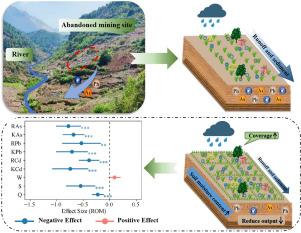草编方格屏障提高了铅锌矿废弃地人工植物群落重金属稳定效率
IF 4.1
2区 环境科学与生态学
Q1 ECOLOGY
引用次数: 0
摘要
铅锌矿废弃地径流和沉积物中重金属的迁移所带来的生态和健康风险日益引起人们的关注。虽然已知草棋盘屏障(SCBs)可以缓解土壤侵蚀,但它们与人工植物群落在控制重金属从这些地点迁移方面的综合效果尚不清楚。为评价秸秆方格屏障和人工植物群落在铅锌矿废弃地缓解土壤侵蚀和控制重金属扩散方面的效果,进行了现场径流小区试验。在荒地上建立了3种人工植物群落模式(草、灌木-草、树-灌木-草),并在每种植物群落模式(草+灌木-草、灌木-草+灌木-草、树-灌木-草+灌木-草)中整合了植物群落。监测地表径流、产沙量和重金属输出(Cd、Pb、As)以研究协同效应。结果表明,在6个降雨事件中,与对照样地相比,人工植物群落减少了累计径流量23.18% ~ 40.11%,产沙量49.55% ~ 75.78%。整合SCBs进一步减少了同一植物群落内17.20% ~ 25.10%的径流量和39.22% ~ 46.30%的产沙量。植物群落建立后,土壤质量显著改善,全氮、全磷、全钾、有机质和土壤水分含量显著增加。在植物群落内建造scb,植被覆盖度和土壤湿度也会增加。随着植物多样性的增加,Cd、Pb和As的累积损失(主要以颗粒形式)显著减少。SCBs进一步提高了植物群落稳定重金属的能力,Cd降低9.36% ~ 19.27%,Pb降低11.99% ~ 17.11%,As降低7.45% ~ 35.66%。影响Cd、Pb和As产出的关键因素包括土壤侵蚀、植被覆盖度、植物群落格局和SCBs的存在。产沙量与重金属损失密切相关,是颗粒Cd输出的最佳预测因子(R2 = 0.979)。综上所述,SCBs整合改善了人工植物群落对废弃铅锌矿地表径流、产沙量和重金属扩散的控制,为生态恢复和长期稳定创造了有利条件。本文章由计算机程序翻译,如有差异,请以英文原文为准。

Straw checkerboard barriers enhance heavy metals stabilization efficiency of artificial plant communities in lead‑zinc mine wastelands
The ecological and health risks posed by heavy metals transport via runoff and sediment from lead‑zinc mine wastelands have attracted increasing attention. While straw checkerboard barriers (SCBs) are known to mitigate soil erosion, their combined effect with artificial plant communities on controlling heavy metals migration from such sites remains unclear. To evaluate the effectiveness of straw checkerboard barriers (SCBs) and artificial plant communities in mitigating soil erosion and controlling heavy metals diffusion in lead‑zinc mine wastelands, a field runoff plot experiment was conducted. Three artificial plant community patterns (grass, shrub-grass, tree-shrub-grass) were established on the wasteland, and SCBs were integrated into each plant community patterns (grass + SCBs, shrub-grass + SCBs, tree-shrub-grass + SCBs). Surface runoff, sediment yield, and heavy metals outputs (Cd, Pb, As) were monitored to investigate synergistic effects. Results demonstrated that artificial plant communities reduced the cumulative runoff by 23.18 % ∼ 40.11 % and sediment yield by 49.55 % ∼ 75.78 % compared to the control plot across six rainfall events. Integrating SCBs further decreased runoff by 17.20 % ∼ 25.10 % and sediment yield by 39.22 % ∼ 46.30 % within the same plant community. Soil quality improved markedly after plant community establishment, with significant increases in total nitrogen, total phosphorus, total potassium, organic matter, and soil moisture content. Vegetation coverage and soil moisture also increased when SCBs were constructed within plant communities. With increasing plant diversity, cumulative losses of Cd, Pb, and As, primarily in the particulate form, decreased significantly. SCBs further improved the ability of plant communities to stabilize heavy metals, reducing Cd by 9.36 % ∼ 19.27 %, Pb by 11.99 % ∼ 17.11 %, and As by 7.45 % ∼ 35.66 %. Key factors influencing Cd, Pb, and As outputs included soil erosion, vegetation coverage, plant community pattern, and the presence of SCBs. Sediment yield was strongly correlated with heavy metals loss and was the best predictor for particulate Cd output (R2 = 0.979). In conclusion, SCBs integration improves artificial plant communities' control of surface runoff, sediment yield, and heavy metals diffusion in abandoned lead‑zinc mine sites, which creates favorable conditions for ecological restoration and long-term stabilization.
求助全文
通过发布文献求助,成功后即可免费获取论文全文。
去求助
来源期刊

Ecological Engineering
环境科学-工程:环境
CiteScore
8.00
自引率
5.30%
发文量
293
审稿时长
57 days
期刊介绍:
Ecological engineering has been defined as the design of ecosystems for the mutual benefit of humans and nature. The journal is meant for ecologists who, because of their research interests or occupation, are involved in designing, monitoring, or restoring ecosystems, and can serve as a bridge between ecologists and engineers.
Specific topics covered in the journal include: habitat reconstruction; ecotechnology; synthetic ecology; bioengineering; restoration ecology; ecology conservation; ecosystem rehabilitation; stream and river restoration; reclamation ecology; non-renewable resource conservation. Descriptions of specific applications of ecological engineering are acceptable only when situated within context of adding novelty to current research and emphasizing ecosystem restoration. We do not accept purely descriptive reports on ecosystem structures (such as vegetation surveys), purely physical assessment of materials that can be used for ecological restoration, small-model studies carried out in the laboratory or greenhouse with artificial (waste)water or crop studies, or case studies on conventional wastewater treatment and eutrophication that do not offer an ecosystem restoration approach within the paper.
 求助内容:
求助内容: 应助结果提醒方式:
应助结果提醒方式:


